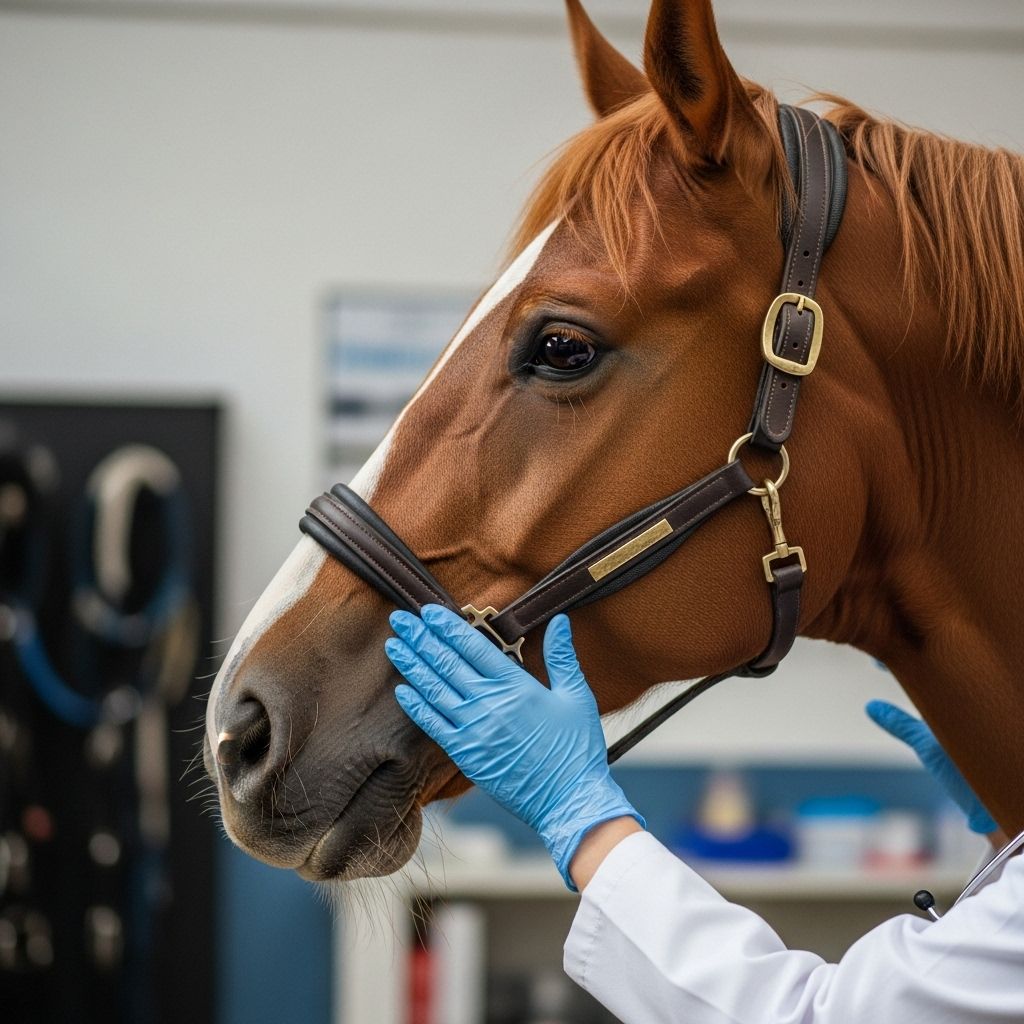NSAIDs for Horses: Types, Uses, Risks, and Veterinary Guidance
Learn about the major NSAIDs for horses, their uses, risks, and veterinary advice for safe pain and inflammation management.

NSAIDs for Horses: Understanding Equine Anti-Inflammatory Medications
Nonsteroidal anti-inflammatory drugs, abbreviated as NSAIDs, are among the most widely used medications for horses, playing a crucial role in managing pain, inflammation, and related health conditions. Whether your horse faces a sudden emergency, chronic discomfort, or recovery from orthopaedic injury, NSAIDs are often at the heart of veterinary treatment protocols. This article provides a comprehensive overview of the main types of NSAIDs available for equines, their uses, risks, and vital guidelines for safe administration based on current veterinary standards.
In This Article
- What Are NSAIDs and How Do They Work?
- Main Types of NSAIDs for Horses
- Indications and Forms of Administration
- Potential Side Effects and Risks
- Veterinary Guidance and Safe Use
- Frequently Asked Questions
What Are NSAIDs and How Do They Work in Horses?
NSAIDs are a class of drugs designed to reduce inflammation and relieve pain by inhibiting the activity of enzymes involved in the body’s inflammatory process. In horses, NSAIDs primarily block cyclooxygenase (COX) enzymes—critical players in the creation of molecules responsible for inflammation and pain signaling. By reducing these enzyme actions, NSAIDs help manage both acute and chronic pain, while also lessening tissue damage associated with inflammatory conditions.
Key NSAIDs Used in Horses
The three main NSAIDs prescribed to horses by veterinarians are:
- Flunixin meglumine (commonly known as Banamine)
- Phenylbutazone (often called “Bute”)
- Firocoxib (marketed as Equioxx)
| NSAID Name | Common Brand | Common Uses | Formulations | Risk Level |
|---|---|---|---|---|
| Flunixin meglumine | Banamine | Colic, musculoskeletal pain, endotoxemia | Injectable, paste, tablet | Moderate; caution with kidneys, gut |
| Phenylbutazone | Bute | Musculoskeletal pain, lameness | Injectable, paste, powder, tablet | Moderate to High; gut, kidney risk |
| Firocoxib | Equioxx | Long-term pain, osteoarthritis, chronic inflammation | Paste, tablet | Lower; safer for long-term use |
Detailed Look at Each NSAID
1. Flunixin Meglumine (Banamine)
- Widely used as a first-line treatment for colic pain, musculoskeletal inflammation, and conditions like endotoxemia.
- Available in injectable, paste, and tablet forms. The paste is generally preferred for ease of administration at home.
- IV administration is most common; IM injections should be avoided due to risk of severe muscle damage and infection.
- Typical dosage: 1.1 mg/kg every 12 hours, as directed by a veterinarian.
- Risks include gastrointestinal irritation (ulcers, colitis) and kidney injury; always use under veterinary supervision.
2. Phenylbutazone (Bute)
- Common for managing musculoskeletal pain, lameness, and chronic inflammatory conditions in horses.
- Available as a powder, tablet, paste, and injectable (the injectable should not be given IM).
- Ease of administration makes powder and paste convenient for owners in emergency situations.
- Potential for a wide dosage range (always follow veterinary advice).
- Prolonged or excessive use can be especially harmful to the gastrointestinal tract and kidneys.
3. Firocoxib (Equioxx)
- A newer, COX-2 selective NSAID with reduced risk of GI and kidney side effects—often preferred for long-term pain relief such as osteoarthritis.
- Comes as paste or tablet, easy to administer.
- Particularly recommended for foals and older horses with increased susceptibility to kidney or gastrointestinal complications.
Indications: Conditions Treated with NSAIDs in Horses
NSAIDs are used to treat a broad range of painful and inflammatory disorders in equines, including:
- Colic (gut pain)
- Musculoskeletal injuries (joints, tendons, ligaments)
- Arthritis and osteoarthritis
- Lameness due to acute or chronic conditions
- Post-surgical pain and swelling
- Septic joints and laminitis
- Acute fever due to infection
- Endotoxemia and systemic inflammatory responses
Forms of Administration: How Are NSAIDs Given to Horses?
Veterinarians may prescribe NSAIDs for horses in various forms, each suited for specific situations and owner preferences:
- Injectable: Fast-acting, typically administered intravenously by professionals.
- Paste: Convenient for owners to administer orally in emergencies or ongoing care.
- Tablet/Powder: Easy to mix into food or feed; powders are favored for broader dosing flexibility.
It is vital to never inject NSAIDs intramuscularly (IM) when not specifically directed, due to the risk of tissue damage and severe infection.
Potential Side Effects and Risks of NSAID Use in Horses
While NSAIDs are invaluable for equine health, their narrow margin of safety means excessive or improper use can quickly lead to serious complications. Veterinarians stress the importance of careful dosing, monitoring, and selection depending on the horse’s condition and overall health. The most significant risks of NSAIDs in horses include:
- Gastroduodenal Ulceration: Ulcers in the stomach and upper intestines, especially with chronic use.
- Right Dorsal Colitis (RDC): A severe inflammation of the right dorsal colon, linked particularly to phenylbutazone.
- Renal Papillary Necrosis: Kidney tissue damage from reduced blood flow, mainly after inappropriate or extended use.
Other less common side effects include:
- Oral ulcers
- Intra-arterial injection risks (seizures, CNS stimulation)
- Subcutaneous infections from improper injectable delivery
- Allergic or idiosyncratic reactions
Comparison Chart: NSAIDs and Their Main Risks
| Drug | Main Adverse Effects | Typical Risk Level |
|---|---|---|
| Phenylbutazone | Ulcers, right dorsal colitis, kidney damage | High (with prolonged use) |
| Flunixin meglumine | GI irritation, kidney issues | Moderate |
| Firocoxib | Lower risk for ulcers and kidney problems | Low |
Safe NSAID Use: Veterinary Guidance and Precautions
- Always seek veterinary consultation before starting a new NSAID, including for emergencies.
- Follow exact dosage instructions—never increase or decrease the dose without guidance.
- Report any signs of gastrointestinal upset (colic, diarrhea, reduced appetite) or unusual urine output to your veterinarian immediately.
- Long-term use should be monitored with bloodwork (kidney function and electrolyte levels) and regular physical exams.
- Do not combine different NSAIDs or give with corticosteroids unless specifically prescribed, as this increases risk of severe adverse effects.
Horses with pre-existing kidney, liver, or gastrointestinal disease may require alternative pain management strategies or adjusted NSAID dosing, reinforcing the need for professional supervision.
Alternatives to NSAIDs for Equine Pain and Inflammation
Depending on the diagnosis and overall health status, veterinarians may pursue alternative therapies, including:
- Corticosteroids for specific inflammatory diseases
- Physical therapies and rest
- Chondroprotective agents (for joint health)
- Adjunctive pain medications for synergistic effect
These alternatives may reduce reliance on NSAIDs and help avoid long-term toxicity, especially in horses needing chronic pain management.
Frequently Asked Questions (FAQs)
Q: Can I give my horse NSAIDs without consulting a veterinarian?
A: No. Always seek veterinary guidance before administering any NSAID. These drugs have a narrow safety margin, and misuse can result in life-threatening complications.
Q: Which NSAID is safest for long-term use?
A: Firocoxib (Equioxx) is considered safer for long-term administration due to its selectivity, reducing risks of ulcers and kidney damage.
Q: What are the signs of NSAID-related toxicity?
A: Common symptoms include loss of appetite, diarrhea, colic, dark or decreased urination, lethargy, and signs of discomfort. Immediate veterinary attention is recommended if any of these occur.
Q: How quickly do NSAIDs act in horses?
A: NSAIDs can begin to relieve pain and inflammation within hours, depending on the route of administration and specific drug used.
Q: Is it safe to combine NSAIDs with other pain medications?
A: This should only be done under veterinary prescription, as combining NSAIDs or using with corticosteroids can increase adverse effects.
Takeaway: The Critical Role of Veterinary Input in NSAID Use
NSAIDs are indispensable for equine pain management, but their benefits come with significant responsibilities. Owners must prioritize veterinary advice, careful dosing, monitoring for side effects, and clear communication about the horse’s health status. By doing so, you ensure maximum comfort and safety for your horse while minimizing risk of serious complications.
Read full bio of medha deb












